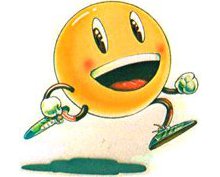
 Controversial for its low quality, the Pac-Man on Atari VCS nevertheless marked a generation. What should we think today of the Atari 2600 port of this essential video game? |

Tod Frye in 2003
|
The author
Tod R. Frye (born 1955) is an American programmer who was employed
at Atari. Although he worked on various projects such as the portable
Breakout, the Atari 8 bit version of Asteroids, the Swordquest series
and three of 2600 prototypes (Save Mary, Shooting Arcade and Xevious),
he is best known for his version of Pac -Man on Atari VCS. Often
criticized, this port was nevertheless a box, contributed to the sales
of the console and was the subject of an international competition in
1982. With the hindsight we have today, how should we consider this
game?
|
 |

In Ntsc or Pal:
A port that differs from the original:
- The shape of the maze
- The color of the decor and the monsters
- Flashing ghosts
- Different gameplay
- The absence of sound in the background
- No interludes
etc

On a Secam console, it's almost better than in Ntsc because the background is black and ghosts a little more visible.
However, we regret the white Pac-Man!
|
Disappointed :(
Undoubtedly,
we can blame a number of things on this Pac-Man. What first strikes the
eye is the labyrinth, which is neither blue nor faithful to the
structure of that of the arcade version. Then, the ghosts all have the
same color and flash horribly (effect reproduced opposite, by
attenuating the presence of the sprites). Finally, the gameplay
includes many differences compared to the original version: the
detection of contact between Pac-Man and ghosts, the latter's movement
strategy, the frequency of appearance of fruits (which are replaced by
a single vitamin )... In addition to these main faults, there are many
additional details: poor sound design, absence of interludes, a slow
and all-white Pac-Man (in the Sécam version), etc. Moreover, between
1982 and 1984, a dozen specialized American magazines did not fail to
point out these faults. In short, a player accustomed to Pac-Man Arcade
has good reason to be disappointed when he discovers the 2600 version.
To this is added the fact that Atari produced 12 million cartridges but
only sold 8 , which is still 4 million unsold... All this sounds like a
flop.
|
 |
The two closest games
of Pac-Man on the other two
console available in 1982 are...

Lock 'n' Chase
(Intellivision)
1982

Gloutons et Voraces (Videopac)
1981
|
And yet :)
Put
back in its period context, the reality is all the same less dark. Let
us remember that in 1982, date of the release of this game on 2600,
there was no adaptation of Pac-Man on the two other consoles of the
moment and that the only titles vaguely approaching it on these systems
were Lock'n'Chase (Intellivision) and Gluttons et Voraces (Videopac).
As for the dedicated consoles (first generation) none had maze games.
The 2600 version was therefore the best, if not the only alternative
for playing Pac-Man at home, and it could boast of having been produced
under official license from Namco. Although the graphics and gameplay
do not adhere to the original, this adaptation is quite playable, the
challenge is present and those who did not know the arcade version had
no comparison criteria. Clearly, the Pac-Man 2600 is a real scoring
game worthy of the name. In addition, it offers eight difficulty
variants to adapt to the level of each player. As far as sales are
concerned, even if 4 million unsold copies remained on Atari's hands,
the game still sold 8 million copies, making it the best-selling game
on the Atari 2600. (for a sales figure of approximately $300 million).
And to those who think that the game has sold, but would have remained
unused, there is only to see the traces of wear that we observe on most
cartridges for sale on the Internet to realize that this game really
made the owners of the Atari VCS happy in 1982.
|
 |


1999 : The Ebivision version

2004: The Pac-Man 8k version
pushes realism to display
the intro screen and the interludes.
|
The historical reasons
One can still wonder why the author of this adaptation did not
seek to adhere more faithfully to the original version. Of course, the
technical constraints come first: The Atari 2600 has a low resolution
graphics mode (40 columns), low capacity cartridges (4 KB - and not 2
KB as some articles claim) and a RAM very restricted (128 bytes). Added
to this is the fact that Tod Frye has chosen to allow a two-player
mode, which means that the maze of the two participants must be
memorized, thus reducing the RAM by half. It may indeed be a strategic
error, because without it, we know that it would have been possible to
have the real labyrinth, as Ébivision had demonstrated with its
Pac-Man, and as others confirmed it by performing more advanced hacks
including a breathtaking 8K version. Regarding the flashing of ghosts,
it must be said that it was the only trick we knew at the time to
multiply the sprites, knowing that the console only has two: one to
display Pac-Man and the other for the four ghosts. To have more
sprites, some games will use the technique of selective flickering (Ms
Pac-Man, Dig Dug, etc.), but unfortunately this had not yet been
developed in 1982 and Tod's Pac-Man Frye was therefore unable to
benefit from it.
|
 |

|
Balance sheet
The grievances against the Pac-Man on the Atari 2600 are completely
understandable and it is true that all the children of 1982 would have
preferred a more faithful version. But this port still filled a gap at
the time by allowing the entire planet to play Pac-Man at home... and
it still allows you to have fun today with a game that has the
advantage over the arcade version of having a particularly retro look,
something to which lovers of the history of video games have always
remained sensitive.
|
 |

|
Some links
|
 |
|

|



